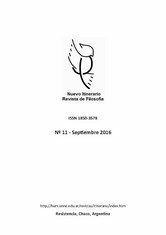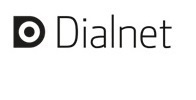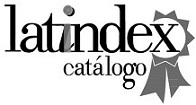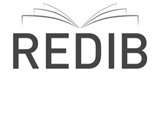The Animal, the Pharmakon and the Self-Deconstruction of the Book
DOI:
https://doi.org/10.30972/nvt.1725762Keywords:
Derrida, animal, book, deconstruction, pharmakonAbstract
In this paper we will attempt to study the link between the notions of the Book and the Animal in Derrida’s work. In the first place we will refer to “Plato’s Pharmacy”, for we believe that this link is best understood under the logic of the double and the unfolding associated with the notion of pharmakon. Secondly, we will turn towards Writing and Difference and Of Grammatology, where we will show how this pharmaco-logic is already at work at least in one crucial element: the constitutive and self-deconstructive structure of the Book, which is haunted by its animal double.
References
Adinolfi, M (2011), “La fine dell’epoca del libro. A partire da Jacques Derrida”, Quaestio, 11, pp. 405-427.
Bass, A. (1984), “The Double Game: An Introduction”, en Smith, J. y Kerrigan, W. Taking Changes: Derrida, Psychoanalysis and Literature, Baltimore, Johns Hopkins University Press.
Bernet, R. (1993), “Derrida-Husserl-Freud: The Trace of Transference”, en The Southern Journal of Philosophy, XXXII, suplemento, pp.141-158.
Cragnolini, M. (2002), “Temblores del pensar: Nietzsche, Blanchot, Derrida”, Pensamiento de los confines, 12, pp. 111-119.
Cragnolini, M (2007), Derrida, un pensador del resto, Buenos Aires, La Cebra.
Cragnolini, M. (2016a), Extraños animales, Buenos Aires, Prometeo.
Cragnolini, M. (2016b), “Lupus in fabula o la cola del lobo: el animal en el discurso y la escritura”, en Instantes y Azares, 17-18, pp. 185-199.
Cragnolini, M. (2019), “Para una deconstrucción del concepto de conciencia, y del lugar del animal en el psicoanálisis”, en Intempestivas, Revista de Filosofía, Psicoanálisis y Cultura, pp. 52-64.
Derrida, J. (1986), De la gramatología [trad. Del Barco y Ceretti], México DF, Siglo Veintiuno.
Derrida, J. (1989), La escritura y la diferencia [trad. Peñalver], Barcelona, Anthropos.
Derrida, J. (1997), La diseminación [trad. Arancibia], Madrid, Editorial Fundamentos.
Derrida, J. (2000), Introducción al origen de la geometría [trad. Cohen], Buenos Aires, Manantial.
Derrida, J. (2008) El animal que luego estoy si(gui)endo [trad. De Peretti y Marciel], Trotta.
Derrida, J. (2019) La vie la mort, Seuil.
Fóti, V. (1985), “Repetition/Subversion: Derrida, Jabès, and The Language of Difference”, Soundings: An Interdisciplinary Journal, Vol. 68, n. 3, pp. 372-387.
Gasché, R. (1986), “Nontotalization Without Spuriousness: Hegel and Derrida on the Infinite”, Journal of the British Society for Phenomenology, Vol. 17, n. 13, pp. 289-307.
Lindberg, S. (2016), “Derrida’s Quasi-Technique”, Research in Phenomenology, 46, pp. 369-389.
Lippit, A. (2000), Electric Animal, Minneapolis, University of Minnesota Press.
Martell, J (2015), “The Animal Mirrors: The Human/Animal Divide in Derrida and Deleuze”, Mosaic: a journal for the interdisciplinary study of literature, vol. 48, n. 3, pp. 175-189.
Naas, M. (2010), “Derrida’s Flair (For the Animals to Follow…)”, Research in Phenomenology, 40, pp. 219-242.
Nietzsche, F. (1997), Así habló Zaratustra [trad. Sánchez Pascual], Madrid, Alianza.
Nietzsche, F. (2011), La genealogía de la moral [trad. Sánchez Pascual], Madrid, Alianza.
Nietzsche, F. (2012), Más allá del bien y del mal [trad. Sánchez Pascual], Madrid, Alianza.
Stiegler, B. (2001), “Derrida and technology: fidelity at the limits of deconstruction and the prosthesis of faith”, en Cohen, T. [ed.], Jacques Derrida and the Humanities, Cambridge, Cambridge University Press.
Vitale, F. (2014), “The Text and the Living: Jacques Derrida between Biology and Deconstruction”, The Oxford Literary Review, Vol. 36, n. 1, pp. 95-114.
Vitale, F. (2017), “Finite Infinity: Reading Gasché Reading Derrida Reading Hegel … ‘and so on without an end’”, CR: The New Centennial Review, vol. 17, n. 3, pp. 43-61.
Vitale, F. (2018), Biodeconstruction [trad. Serratore], Albany, Suny Press.
Downloads
Published
How to Cite
Issue
Section
License
Les autores ceden a Nuevo Itinerario los derechos de publicidad de sus trabajos, toda vez que hayan sido admitidos como parte de alguno de sus números. Ello no obstante, les autores retienen los derechos de propiedad intelectual y responsabilidad ética así como la posibilidad de dar difusión propia por los medios que consideren.












51.jpg)

